2012 年ACS《癌症预防的营养与运动指南》解读
美国癌症学会关于癌症预防的营养与身体活动指南推荐
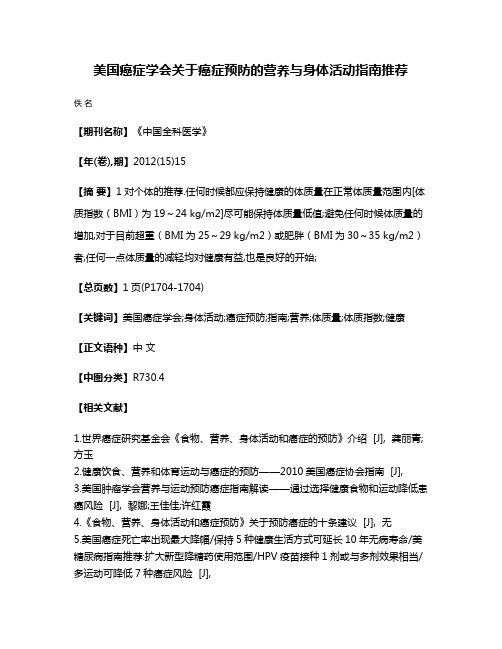
美国癌症学会关于癌症预防的营养与身体活动指南推荐
佚名
【期刊名称】《中国全科医学》
【年(卷),期】2012(15)15
【摘要】1对个体的推荐.任何时候都应保持健康的体质量在正常体质量范围内[体质指数(BMI)为19~24 kg/m2]尽可能保持体质量低值;避免任何时候体质量的增加,对于目前超重(BMI为25~29 kg/m2)或肥胖(BMI为30~35 kg/m2)者,任何一点体质量的减轻均对健康有益,也是良好的开始;
【总页数】1页(P1704-1704)
【关键词】美国癌症学会;身体活动;癌症预防;指南;营养;体质量;体质指数;健康【正文语种】中文
【中图分类】R730.4
【相关文献】
1.世界癌症研究基金会《食物、营养、身体活动和癌症的预防》介绍 [J], 龚丽青;方玉
2.健康饮食、营养和体育运动与癌症的预防——2010美国癌症协会指南 [J],
3.美国肿瘤学会营养与运动预防癌症指南解读——通过选择健康食物和运动降低患癌风险 [J], 黎娜;王佳佳;许红霞
4.《食物、营养、身体活动和癌症预防》关于预防癌症的十条建议 [J], 无
5.美国癌症死亡率出现最大降幅/保持5种健康生活方式可延长10年无病寿命/美糖尿病指南推荐:扩大新型降糖药使用范围/HPV疫苗接种1剂或与多剂效果相当/多运动可降低7种癌症风险 [J],
因版权原因,仅展示原文概要,查看原文内容请购买。
适量运动防癌抗癌的十大机理
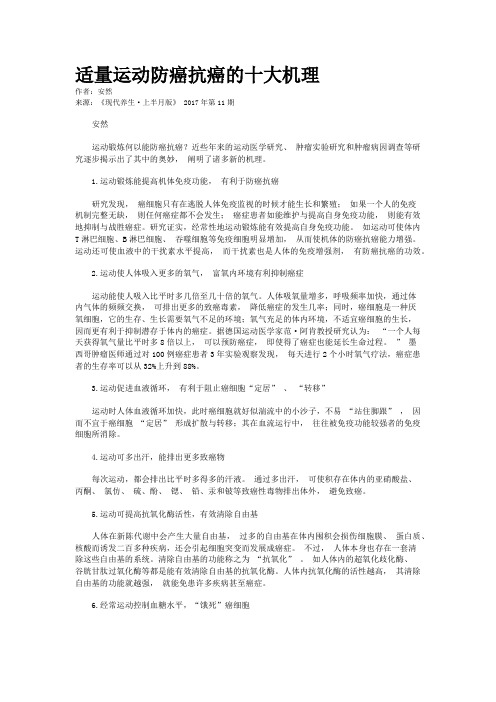
适量运动防癌抗癌的十大机理作者:安然来源:《现代养生·上半月版》 2017年第11期安然运动锻炼何以能防癌抗癌?近些年来的运动医学研究、肿瘤实验研究和肿瘤病因调查等研究逐步揭示出了其中的奥妙,阐明了诸多新的机理。
1.运动锻炼能提高机体免疫功能,有利于防癌抗癌研究发现,癌细胞只有在逃脱人体免疫监视的时候才能生长和繁殖;如果一个人的免疫机制完整无缺,则任何癌症都不会发生;癌症患者如能维护与提高自身免疫功能,则能有效地抑制与战胜癌症。
研究证实,经常性地运动锻炼能有效提高自身免疫功能。
如运动可使体内T淋巴细胞、B淋巴细胞、吞噬细胞等免疫细胞明显增加,从而使机体的防癌抗癌能力增强。
运动还可使血液中的干扰素水平提高,而干扰素也是人体的免疫增强剂,有防癌抗癌的功效。
2.运动使人体吸入更多的氧气,富氧内环境有利抑制癌症运动能使人吸入比平时多几倍至几十倍的氧气。
人体吸氧量增多,呼吸频率加快,通过体内气体的频频交换,可排出更多的致癌毒素,降低癌症的发生几率;同时,癌细胞是一种厌氧细胞,它的生存、生长需要氧气不足的环境;氧气充足的体内环境,不适宜癌细胞的生长,因而更有利于抑制潜存于体内的癌症。
据德国运动医学家范·阿肯教授研究认为:“一个人每天获得氧气量比平时多8倍以上,可以预防癌症,即使得了癌症也能延长生命过程。
” 墨西哥肿瘤医师通过对100例癌症患者3年实验观察发现,每天进行2个小时氧气疗法,癌症患者的生存率可以从32%上升到88%。
3.运动促进血液循环,有利于阻止癌细胞“定居” 、“转移”运动时人体血液循环加快,此时癌细胞就好似湍流中的小沙子,不易“站住脚跟” ,因而不宜于癌细胞“定居” 形成扩散与转移;其在血流运行中,往往被免疫功能较强者的免疫细胞所消除。
4.运动可多出汗,能排出更多致癌物每次运动,都会排出比平时多得多的汗液。
通过多出汗,可使积存在体内的亚硝酸盐、丙酮、氯仿、硫、酚、锶、铅、汞和铍等致癌性毒物排出体外,避免致癌。
运动抗癌的过去、现在与未来

Journal of Chengdu Sport University Vol.47No.2.2021成都体育学院学报2021年(第47卷)第2期DOI:10.15942/j.jcsu.2021.02.00l 运动抗癌的过去、现衽与未来朱为模摘要:近几十年的国内外研究,证明了运动在预防和治疗人类癌症中的积极作用。
运动在国外已经作为“协同药”进入癌症治疗的临床第一线,运动肿瘤学作为一门新兴学科也因此诞生和成长。
文章回顾了国内外运动抗癌发展史,分析了其发展现状,并对未来的研究主攻方向和实践中亟需解决的问题进行了展望与阐述。
关键词:运动是良药;运动处方;循证医学中图分类号:G804.3文献标志码:A文章编号:1001-9154(2021)02-0001-08癌症是因为异常细胞侵入其他组织,扩散至身体的其他部位并失控生长的疾病。
由于现代人不健康的生活方式(如抽烟、不运动、吃垃圾食品、压力大、肥胖等)和人口的老龄化,癌症在很多国家已经一跃成为人类的主要杀手之一。
过去得了癌症,临床医生通常是建议患者休息并避免体育锻炼或运动。
但从20世纪80年代起大量运动与癌症的研究让人们开始重新认识运动在癌症预防和治疗中的积极作用。
有关研究的数量也呈指数级增长,据统计,在过去10年中,已有数千项运动与癌症治疗的随机对照试验,多个大型流行病学和临床研究得以完成,所有这些都扩展了我们对这个领域的认知。
现在我们已经有足够科学证据来证明患有癌症的人能从运动中受益,一门新兴的癌症治疗学科即运动肿瘤学(Exercise Oncology)也应运而生。
随着研究的进一步深入,在不久的将来就可以像用药一样,精确地用运动来参与癌症的治疗和干预。
本文旨在通过对运动抗癌发展历史回顾,对未来发展的展望,以及对运动肿瘤学做的系统介绍,以期待更多的学者参与这个新学科的研究和实践,为人类战胜这个凶险的疾病共同奋斗。
1运动抗癌的过去1.1概念的提出:癌症病人创造了历史其实国外用运动来抗癌的历史并不很长。
癌症患者的临床运动指导
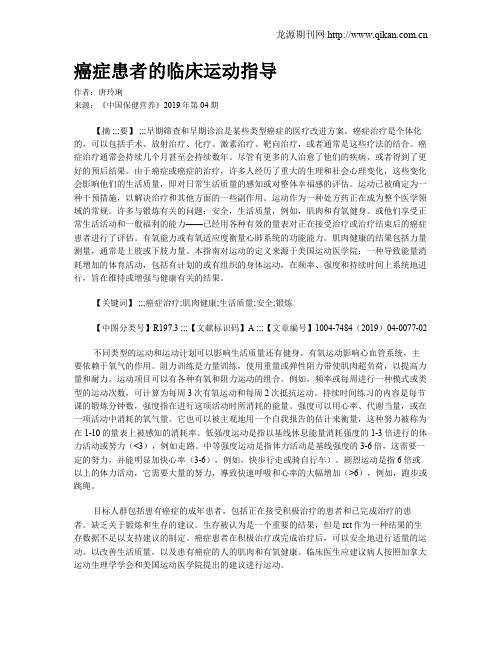
癌症患者的临床运动指导作者:唐玲琍来源:《中国保健营养》2019年第04期【摘 ;;;要】 ;;;早期筛查和早期诊治是某些类型癌症的医疗改进方案。
癌症治疗是个体化的,可以包括手术、放射治疗、化疗、激素治疗、靶向治疗,或者通常是这些疗法的结合。
癌症治疗通常会持续几个月甚至会持续数年。
尽管有更多的人治愈了他们的疾病,或者得到了更好的预后结果。
由于癌症或癌症的治疗,许多人经历了重大的生理和社会心理变化,这些变化会影响他们的生活质量,即对日常生活质量的感知或对整体幸福感的评估。
运动已被确定为一种干预措施,以解决治疗和其他方面的一些副作用。
运动作为一种处方药正在成为整个医学领域的常规。
许多与锻炼有关的问题:安全,生活质量,例如,肌肉和有氧健身。
或他们享受正常生活活动和一般福利的能力——已经用各种有效的量表对正在接受治疗或治疗结束后的癌症患者进行了评估。
有氧能力或有氧适应度衡量心肺系统的功能能力。
肌肉健康的结果包括力量测量,通常是上肢或下肢力量。
本指南对运动的定义来源于美国运动医学院:一种导致能量消耗增加的体育活动,包括有计划的或有组织的身体运动,在频率、强度和持续时间上系统地进行,旨在维持或增强与健康有关的结果。
【关键词】 ;;;癌症治疗;肌肉健康;生活质量;安全;锻炼【中图分类号】R197.3 ;;;【文献标识码】A ;;;【文章编号】1004-7484(2019)04-0077-02不同类型的运动和运动计划可以影响生活质量还有健身。
有氧运动影响心血管系统,主要依赖于氧气的作用。
阻力训练是力量训练,使用重量或弹性阻力带使肌肉超负荷,以提高力量和耐力。
运动项目可以有各种有氧和阻力运动的组合。
例如,频率或每周进行一种模式或类型的运动次数,可计算为每周3次有氧运动和每周2次抵抗运动。
持续时间练习的内容是每节课的锻炼分钟数,强度指在进行这项活动时所消耗的能量。
强度可以用心率、代谢当量,或在一项活动中消耗的氧气量。
家庭肠外营养指南解读完整版
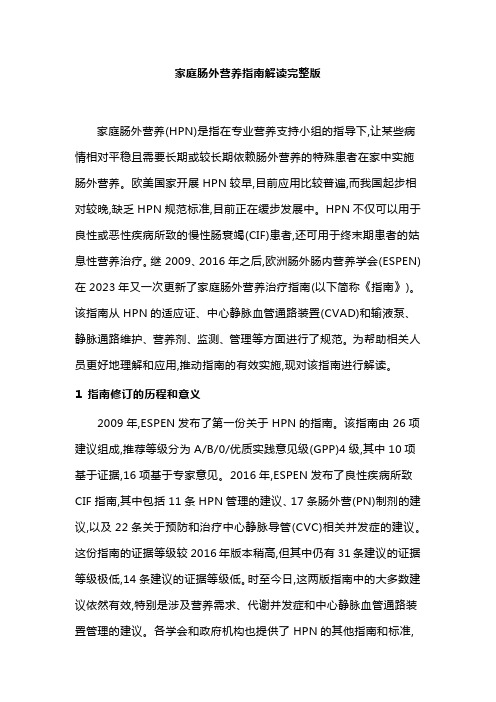
家庭肠外营养指南解读完整版家庭肠外营养(HPN)是指在专业营养支持小组的指导下,让某些病情相对平稳且需要长期或较长期依赖肠外营养的特殊患者在家中实施肠外营养。
欧美国家开展HPN较早,目前应用比较普遍,而我国起步相对较晚,缺乏HPN规范标准,目前正在缓步发展中。
HPN不仅可以用于良性或恶性疾病所致的慢性肠衰竭(CIF)患者,还可用于终末期患者的姑息性营养治疗。
继2009、2016年之后,欧洲肠外肠内营养学会(ESPEN)在2023年又一次更新了家庭肠外营养治疗指南(以下简称《指南》)。
该指南从HPN的适应证、中心静脉血管通路装置(CVAD)和输液泵、静脉通路维护、营养剂、监测、管理等方面进行了规范。
为帮助相关人员更好地理解和应用,推动指南的有效实施,现对该指南进行解读。
1 指南修订的历程和意义2009年,ESPEN发布了第一份关于HPN的指南。
该指南由26项建议组成,推荐等级分为A/B/0/优质实践意见级(GPP)4级,其中10项基于证据,16项基于专家意见。
2016年,ESPEN发布了良性疾病所致CIF指南,其中包括11条HPN管理的建议、17条肠外营(PN)制剂的建议,以及22条关于预防和治疗中心静脉导管(CVC)相关并发症的建议。
这份指南的证据等级较2016年版本稍高,但其中仍有31条建议的证据等级极低,14条建议的证据等级低。
时至今日,这两版指南中的大多数建议依然有效,特别是涉及营养需求、代谢并发症和中心静脉血管通路装置管理的建议。
各学会和政府机构也提供了HPN的其他指南和标准,然而,一项系统评价显示,这些指南之间存在显著差异。
因此,2020年ESPEN发布了新版HPN指南,纳入自前版发布以来的新证据,强调了关于HPN安全给药的建议,并纳入患者的观点。
2023年发布的指南在其基础上,简短精确地指导临床实践,该指南不包括针对特定条件下患者营养需求的建议,更多的是在实践层面给予指导。
2 家庭肠外营养的适应证与其他HPN相关指南一样,本《指南》指出,HPN应用于无法通过口服和/或肠内途径满足其营养需求且可以在院外安全管理肠外营养的患者(GPP级,强烈共识,同意率95.8%),但本次《指南》对于HPN的适应证进行了更为详细的罗列举例和阐述,见图1。
饮食与癌症预防:关键营养素的作用

• 建议从食物中摄取维生素和矿物质,而非依赖补充剂
维生素与矿物质的作用机制
• 维生素和矿物质是维持正常生理功能所必需的营养素
• 某些维生素和矿物质具有抗氧化作用,降低癌症风险
• 维生素和矿物质可以调节细胞信号通路,抑制癌细胞生长
03
抗癌饮食指南
均衡膳食与癌症预防
癌症风险
抗氧化剂与癌症预防的研究
• 某些抗氧化剂被证实具有抗癌作用
• 抗氧化剂补充剂对癌症预防的效果尚不
明确
• 建议从食物中摄取抗氧化剂,而非依赖
补充剂
植物化学物质与癌症预防
植物化学物质的种类和来源
植物化学物质与癌症预防的研究
• 植物化学物质包括类胡萝卜素、异黄
• 某些植物化学物质被证实具有抗癌作
个性化抗癌饮食指导
建议遵循均衡
根据个人体质、
膳食原则,多
饮食习惯和生
摄入富含抗氧
关注食物搭配
活方式制定个
化剂、植物化
和烹饪方式,
性化抗癌饮食
学物质和维生
确保营养均衡
指导
素矿物质的食
物
01
02
03
未来研究方向与挑战
未来研究方向
挑战
• 深入研究关键营养素在癌症
• 如何制定针对个体的抗癌饮
预防中的作用机制
• 过量饮酒与多种癌症的风险增加有关
• 饮酒可能增加乳腺癌、口腔癌、食管癌等癌症的风险
• 适量饮酒对癌症预防的影响尚不明确
05
总结与展望
关键营养素在癌症预防中的重要性
01
关键营养素对维持正常生理功能和免疫系统功能至关重要
02
2012 ACS 癌症预防的营养与运动指南
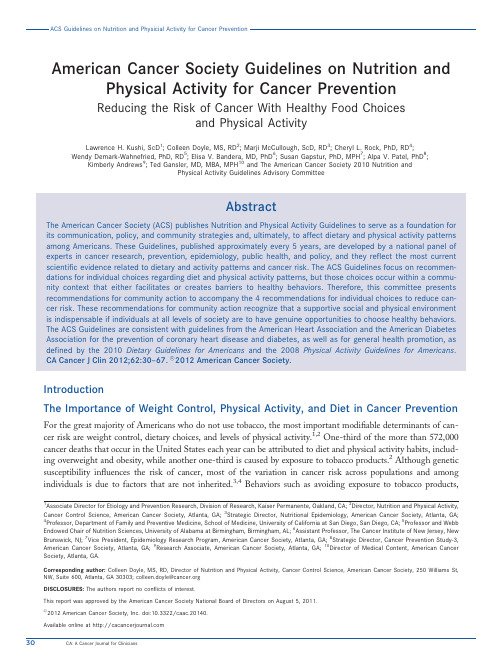
American Cancer Society Guidelines on Nutrition and Physical Activity for Cancer PreventionReducing the Risk of Cancer With Healthy Food Choicesand Physical ActivityLawrence H.Kushi,ScD1;Colleen Doyle,MS,RD2;Marji McCullough,ScD,RD3;Cheryl L.Rock,PhD,RD4;Wendy Demark-Wahnefried,PhD,RD5;Elisa V.Bandera,MD,PhD6;Susan Gapstur,PhD,MPH7;Alpa V.Patel,PhD8;Kimberly Andrews9;Ted Gansler,MD,MBA,MPH10and The American Cancer Society2010Nutrition andPhysical Activity Guidelines Advisory CommitteeAbstractThe American Cancer Society(ACS)publishes Nutrition and Physical Activity Guidelines to serve as a foundation for its communication,policy,and community strategies and,ultimately,to affect dietary and physical activity patterns among Americans.These Guidelines,published approximately every5years,are developed by a national panel of experts in cancer research,prevention,epidemiology,public health,and policy,and they reflect the most current scientific evidence related to dietary and activity patterns and cancer risk.The ACS Guidelines focus on recommen-dations for individual choices regarding diet and physical activity patterns,but those choices occur within a commu-nity context that either facilitates or creates barriers to healthy behaviors.Therefore,this committee presents recommendations for community action to accompany the4recommendations for individual choices to reduce can-cer risk.These recommendations for community action recognize that a supportive social and physical environment is indispensable if individuals at all levels of society are to have genuine opportunities to choose healthy behaviors.The ACS Guidelines are consistent with guidelines from the American Heart Association and the American Diabetes Association for the prevention of coronary heart disease and diabetes,as well as for general health promotion,as defined by the2010Dietary Guidelines for Americans and the2008Physical Activity Guidelines for Americans.CA Cancer J Clin2012;62:30–67.V C2012American Cancer Society.IntroductionThe Importance of Weight Control,Physical Activity,and Diet in Cancer Prevention For the great majority of Americans who do not use tobacco,the most important modifiable determinants of can-cer risk are weight control,dietary choices,and levels of physical activity.1,2One-third of the more than572,000 cancer deaths that occur in the United States each year can be attributed to diet and physical activity habits,includ-ing overweight and obesity,while another one-third is caused by exposure to tobacco products.2Although genetic susceptibility influences the risk of cancer,most of the variation in cancer risk across populations and among individuals is due to factors that are not inherited.3,4Behaviors such as avoiding exposure to tobacco products, 1Associate Director for Etiology and Prevention Research,Division of Research,Kaiser Permanente,Oakland,CA;2Director,Nutrition and Physical Activity, Cancer Control Science,American Cancer Society,Atlanta,GA;3Strategic Director,Nutritional Epidemiology,American Cancer Society,Atlanta,GA;4Professor,Department of Family and Preventive Medicine,School of Medicine,University of California at San Diego,San Diego,CA;5Professor and Webb Endowed Chair of Nutrition Sciences,University of Alabama at Birmingham,Birmingham,AL;6Assistant Professor,The Cancer Institute of New Jersey,New Brunswick,NJ;7Vice President,Epidemiology Research Program,American Cancer Society,Atlanta,GA;8Strategic Director,Cancer Prevention Study-3, American Cancer Society,Atlanta,GA;9Research Associate,American Cancer Society,Atlanta,GA;10Director of Medical Content,American Cancer Society,Atlanta,GA.Corresponding author:Colleen Doyle,MS,RD,Director of Nutrition and Physical Activity,Cancer Control Science,American Cancer Society,250Williams St, NW,Suite600,Atlanta,GA30303;colleen.doyle@DISCLOSURES:The authors report no conflicts of interest.This report was approved by the American Cancer Society National Board of Directors on August5,2011.V C2012American Cancer Society,Inc.doi:10.3322/caac.20140.Available online at 30CA:A Cancer Journal for Cliniciansmaintaining a healthy weight,staying physically active throughout life,and consuming a healthy diet can substantially reduce one’s lifetime risk of developing,5,6 or dying from,5,7cancer.2,8-11These same behaviors are also associated with a decreased risk of developing cardiovascular disease and diabetes.12Indeed,a recent study demonstrated that nonsmoking(former and never smokers)adult men and women whose lifestyles were most consistent with the2006American Cancer Society(ACS)cancer prevention guidelines for weight control,diet,physical activity,and alcohol had a significantly lower risk of dying from cancer,cardio-vascular disease,or all causes combined.7 Although these healthy choices are made by indi-viduals,they may be facilitated or impeded by the social,physical,economic,and regulatory environ-ment in which people munity efforts are therefore essential to create an environment that facilitates healthy food choices and physical activity. Overview of the GuidelinesThe ACS publishes Nutrition and Physical Activity Guidelines to advise health care professionals,policy-makers,and the general public about dietary and other lifestyle practices that reduce cancer risk.13 These Guidelines,updated in2012by the ACS Nutrition and Physical Activity Guidelines Advisory Committee,are based on synthesis of the current scientific evidence on diet and physical activity in relation to cancer risk.The Committee reviewed evi-dence from human population studies and laboratory experiments published since the last release of the Guidelines in2006.13The Committee also consid-ered other comprehensive reviews of diet,obesity, and physical inactivity in relation to cancer.For many aspects of nutrition and physical activity,the most thorough reviews were the2007World Cancer Research Fund/American Institute for Cancer Research(WCRF/AICR)report and the subsequent Continuous Update reports on breast cancer14and colorectal cancer15;other comprehensive reviews or meta-analyses that were published in recent years were also considered.16In weighing the evidence from randomized controlled trials(RCTs),the Committee considered thefindings in relation to the design of the trial,the specific question being addressed,and the importance of the trial results in the context of other evidence from human populations.Prospective cohort studies were weighted more heav-ily than case-control studies,especially when results were available from several cohorts.Population-based case-control studies with at least200cases of cancer were considered more informative than smaller or hospital-based case-control studies.Studies that adjusted for total energy intake,considered other dietary factors,and controlled for other known risk factors were considered more credible than those that failed to meet these criteria.For many issues concerning nutrition and cancer,the evidence is not definitive because the published results are inconsistent or because the methods of studying nutrition and chronic disease in human populations continue to evolve.Part of the uncer-tainty has resulted from studies that focus on specific nutrients or foods in isolation,thereby oversimplify-ing the complexity of foods and dietary patterns;the importance of the dose,timing,and duration of exposure;and the large variations in nutritional sta-tus among human populations.Nutrition and physi-cal activity research is equally challenging in RCTs, generally considered the gold standard for scientific inference.Studies may fail tofind an effect if the intervention begins too late in life,is too small,or ifthe follow-up is too short for a benefit to appear.In addition,RCTs of lifestyle interventions cannot be blinded,and disease endpoints such as cancer require many years of follow-up.No single trial can resolve allof the questions that are relevant to the potential effects of nutrition throughout the lifespan.Moreover, many important questions about how diet,physical activity,and obesity relate to cancer cannot presentlybe addressed in RCTs.For example,while there is substantial interest in the effects of early-life body size and dietary patterns on the risk of adult cancer,it is practically not feasible to conduct RCTs to determinethe long-term consequences of interventions that begin in infancy and extend for many years.Inferences about the many complex interrelation-ships between body weight,physical activity,diet, and cancer risk are therefore based,for the most part,on a combination of shorter-term clinical trials and observational studies coupled with advancing understanding of the biology of cancer.These Guidelines are based on the totality of evidence from these sources,taking into account both the potential health benefits and possible risks from adopting them.No diet or lifestyle pattern can guarantee fullVOLUME62_NUMBER1_JANUARY/FEBRUARY201231protection against any disease;the potential health benefit represents a decreased likelihood that the disease will occur,not a guarantee of total protec-tion.These Guidelines provide a summary of the existing scientific information about weight control, physical activity,and nutrition in relation to cancer and are intended to be followed as a whole.The ACS Guidelines are consistent with guidelines established for cancer prevention by other governmental and non-governmental organizations2,10;those from the American Heart Association17and the American Diabetes Association18for the prevention of coro-nary heart disease and diabetes;and those for general health promotion,as defined by the2010Dietary Guidelines for Americans19and the2008Physical Activity Guidelines for Americans.20In addition to recommendations regarding indi-vidual choices,the ACS Guidelines underscore what communities can and should do to facilitate healthy eating and physical activity behaviors(Table1).The recommendations for community action recognize that a supportive social and physical environment is indispensable if individuals at all levels of society are to have genuine opportunities to choose and main-tain healthy behaviors.ACS Guidelines for Nutrition and Physical ActivityRecommendations for Community Action Social,economic,and cultural factors strongly influ-ence individual choices about diet and physical activ-ity.21-24Although many Americans would like to adopt a healthy lifestyle,many encounter substantial barriers that make it difficult to follow diet and activity guidelines.21,22,24Indeed,according to the Institute of Medicine,‘‘It is unreasonable to expectTABLE1.American Cancer Society Guidelines on Nutrition and Physical Activity for Cancer PreventionACS RECOMMENDATIONS FOR INDIVIDUAL CHOICESAchieve and maintain a healthy weight throughout life.l Be as lean as possible throughout life without being underweight.l Avoid excess weight gain at all ages.For those who are currently overweight or obese,losing even a small amount of weight has health benefits andis a good place to start.l Engage in regular physical activity and limit consumption of high-calorie foods and beverages as key strategies for maintaining a healthy weight.Adopt a physically active lifestyle.l Adults should engage in at least150minutes of moderate intensity or75minutes of vigorous intensity activity each week,or an equivalent combination, preferably spread throughout the week.l Children and adolescents should engage in at least1hour of moderate or vigorous intensity activity each day,with vigorous intensity activity occurring at least3days each week.l Limit sedentary behavior such as sitting,lying down,watching television,or other forms of screen-based entertainment.l Doing some physical activity above usual activities,no matter what one’s level of activity,can have many health benefits.Consume a healthy diet,with an emphasis on plant foods.l Choose foods and beverages in amounts that help achieve and maintain a healthy weight.l Limit consumption of processed meat and red meat.l Eat at least2.5cups of vegetables and fruits each day.l Choose whole grains instead of refined grain products.If you drink alcoholic beverages,limit consumption.l Drink no more than1drink per day for women or2per day for men.ACS RECOMMENDATIONS FOR COMMUNITY ACTIONPublic,private,and community organizations should work collaboratively at national,state,and local levels to implement policy and environmentalchanges that:l Increase access to affordable,healthy foods in communities,worksites,and schools,and decrease access to and marketing of foods and beveragesof low nutritional value,particularly to youth.l Provide safe,enjoyable,and accessible environments for physical activity in schools and worksites,and for transportation and recreation in communities.ACS indicates American Cancer Society.32CA:A Cancer Journal for Cliniciansthat people will change their behavior easily when so many forces in the social,cultural,and physical envi-ronment conspire against such change.’’25Access to and affordability of healthy foods,the availability and extensive marketing of high-calorie foods and beverages of low nutritional value,and barriers to the ability of individuals to be physi-cally active for recreation and transportation in communities have all been implicated as contribu-tors to obesity trends in the United States.24,26 Avoiding unhealthy weight gain,therefore,goes beyond‘‘personal responsibility’’and an individual’s ability to achieve healthy diet and physical activity habits.Reversing obesity trends will require a broad range of multilevel strategies that include policy and environmental changes.These Guidelines therefore emphasize the impor-tance of public,private,and community organiza-tions working collaboratively at national,state,and local levels to implement policy and environmental changes that:Increase access to affordable,healthy foods in com-munities,worksites,and schools,and decrease access to and marketing of foods and beverages of low nutritional value,particularly to youth.Provide safe,enjoyable,and accessible environments for physical activity in schools and worksites,and for transportation and recreation in communities. Current trends toward increasing portion sizes27-29; the consumption of high-calorie convenience foods, sugar-sweetened beverages,and restaurant meals;and declining levels of physical activity are contributing to an obesity epidemic among Americans of all ages and across all population segments.30-32Longer workdays and more households with multiple wage earners reduce the amount of time available for the prepara-tion of meals,with a resulting shift toward the increased consumption of high-calorie foods outside the home,which are frequently less nutritious than foods prepared at home.33Large portion sizes, calorie-dense foods,and sugar-sweetened beverages are extensively marketed by restaurants,supermarkets, and food and beverage companies.29,32,34,35Reduced leisure time,increased amounts of time spent sitting, increased reliance on automobiles for transportation, and increased availability of electronic entertainment and communications media all contribute to reduced levels of physical activity.36-38There is increasing evi-dence of associations between the built environment and obesity and physical activity levels.36,39,40Poor access to sidewalks,parks,and recreation facilities is associated with greater obesity risk,41whereas neigh-borhoods that facilitate walking and safe physical recreation have lower obesity prevalence.21-24The increase in overweight and obesity noted among Americans is of particular concern for a num-ber of population groups,including children,whoare establishing lifelong behavioral patterns that affect health,and people who live in lower income neighborhoods,which are often characterized by nearby stores that lack affordable,high-quality healthy foods,and increased safety concerns that may limit opportunities for physical activity.Evidence suggests that obese children are more likely than normal-weight children to become obese adults,and that their obesity in adulthood is likely tobe more severe.42-44Promoting the establishment of healthy behaviors among youth is more effective, and often easier,than efforts to change unhealthy behaviors already established in adult populations. Therefore,creating environments that make it easierfor children to establish positive eating and physical activity habits early in life are critical.45Improvingthe school environment through policies that require daily,quality physical education and healthier food and beverage choices,and that limit the availabilityof and access to foods and beverages of low nutri-tional value;limiting advertising and marketing of less healthy foods and beverages;and ensuring com-munities have safe places to play,as well as routes that facilitate bicycling and walking to school,are important strategies to consider in addressing youth obesity trends.24,46While all Americans face obstacles to making healthy choices,the challenges are compounded for lower income and racial/ethnic minority groups,who frequently face additional barriers to making healthy food and physical activity choices.Access to super-markets has been associated with more healthful diets, greater consumption of vegetables and fruits,and lower rates of obesity,47,48and numerous studies have shown that communities with a greater proportion of ethnic minority and low-socioeconomic status resi-dents can be characterized as‘‘food deserts’’(ie,they tend to have fewer supermarkets that carry healthy, affordable,high-quality foods).49-51Limited access to supermarkets frequently results in residents shoppingfor food at local convenience stores,where healthyVOLUME62_NUMBER1_JANUARY/FEBRUARY201233food options tend to be fewer,of lesser quality,and more expensive.52Even in neighborhoods where supermarkets are available,low-income residents may more frequently purchase a diet of less expensive, higher-calorie foods;studies have suggested that lower cost foods comprise a greater proportion of the diet of lower income individuals.53Studies also sug-gest that these neighborhoods,as compared with more affluent areas,have greater access to fast food restaurants and other restaurants that are less likely to offer healthier options.50,54,55Research also points to disparities in the built environment,which likely contribute to differences in physical activity.Access to parks,gyms,and other opportunities for physical activity,such as the avail-ability of sidewalks and the close proximity of resi-dential areas to stores,jobs,schools,and recreation centers,have been shown to contribute to more physi-cally active lifestyles.56,57However,studies have found significantly fewer sports areas,parks,greenways, and bike paths in high-poverty areas when compared with areas with lower poverty rates.Even when these facilities are available,cost factors,distance from physical activity facilities,and transportation avail-ability may still affect access among low-income populations.58,59Heavy traffic,lack of street light-ing,unleashed dogs,high crime rates,and a lack of sidewalks and traffic calming measures are other factors that may present barriers to physical activity, particularly in low-income areas.Ensuring that all Americans have access to afford-able,healthy food choices and opportunities for safe physical activity will require multiple strategies and bold action,ranging from the implementation of community,worksite,school,and other health pro-motion programs to policies that affect community planning,transportation,school-based physical edu-cation,food advertising and marketing,and food services.Public,private,and community organiza-tions at local,state,and national levels will need to implement new policies and reallocate or expand resources to facilitate necessary changes.Health care professionals;school,business,faith group,and other community leaders;and policy makers all have opportunities to provide leadership and to promote purposeful changes in public policy and in commu-nity environments that are necessary to help individ-uals maintain a healthy body weight and remain physically active throughout life.Recommendations for Individual Choices Although the previously rapid increases in obesity prevalence appear to be leveling off in women and possibly in men,approximately two-thirds of Ameri-cans are overweight or obese.60The percentage of children,adolescents,and adult men who are over-weight or obese has continued to increase through 2004,although the trend has now stabilized in adult women and youth.60-62In addition,many Americans are less physically active than is optimal for health. Obesity increases the risk of many cancers,and also has adverse effects on coronary heart disease,stroke, type2diabetes,and other health outcomes,including premature mortality.Thus,while there continues to be scientific uncertainty about how specific aspects of excess adiposity,excessive energy intake,and physical inactivity relate to cancer,there is no debate that these contribute to an increased risk of many types of cancer and that they constitute a serious and growing health problem.These Guidelines therefore emphasize the importance of achieving or maintain-ing a healthy body weight;adopting a physically active lifestyle;consuming a healthy diet that emphasizes plant foods,particularly within the con-text of weight management;and limiting consump-tion of alcoholic beverages.1.Achieve and Maintain a Healthy Weight Throughout Life•Be as lean as possible throughout life without being underweight.•Avoid excess weight gain at all ages.For those who are currently overweight or obese,losing even a small amount of weight has health ben-efits and is a good place to start.•Engage in regular physical activity and limit consumption of high-calorie foods and beverages as key strategies for maintaining a healthy weight. Body Weight and Cancer RiskIn the United States,it has been estimated that over-weight and obesity contribute to14%to20%of all cancer-related mortality.63Overweight and obesity are clearly associated with an increased risk of devel-oping many cancers,including cancers of the breast in postmenopausal women,14colon and rectum,15 endometrium,kidney and adenocarcinoma of the esophagus,and pancreas2,64;are probably associated with an increased risk of cancer of the gallbladder2; and may also be associated with an increased risk34CA:A Cancer Journal for Cliniciansof cancer of the liver,non-Hodgkin lymphoma, multiple myeloma,cancer of the cervix,cancer of the ovary,and aggressive prostate cancer.63,65-70In addition,abdominal fatness is convincingly associ-ated with colorectal cancer,and probably related to a higher risk of pancreatic,endometrial,and post-menopausal breast cancer.2Overweight and obesity are thought to affect the risk of these cancers through a variety of mecha-nisms,some of which are specific to particular cancer types.These mechanisms include effects on immune function and inflammation;levels and metabolism of several hormones,including insulin and estradiol; factors that regulate cell proliferation and growth, such as insulin-like growth factor(IGF)-1;and pro-teins that make hormones more or less available to tissues,such as sex hormone-binding globulin and IGF-binding proteins.71-73Overweight and obesity may increase the risk of adenocarcinoma of the esophagus by increasing the risk of gastroesophageal reflux disease and Barrett esophagus.74,75Most research on energy imbalance and cancer focuses on increased risks associated with overweight and obesity.Some studies exploring intentional weight loss suggest that losing weight may reduce the risk of postmenopausal breast cancer76-78and possibly other cancers.79Results from large studies of lifestyle and behavioral weight loss interventions have shown that modest weight loss improves insulin sensitivity and biochemical measures of hormone metabolism, which have been postulated to contribute to the rela-tionship between obesity and certain cancers.79,80 Examples include the Diabetes Prevention Program Study81and the Action for Health in Diabetes (Look AHEAD)study,82,83both of which used life-style interventions to promote weight loss.Even though our knowledge about the relationship between weight loss and cancer risk is incomplete,individuals who are overweight or obese should be encouraged and supported in their efforts to reduce their weight. Achieving and Maintaining a Healthy WeightA healthy weight depends on a person’s height,so rec-ommendations for a healthy weight are often expressed in terms of a body mass index(BMI)(Table2). Although BMI is not a direct measure of adiposity, it is simple to measure and widely used clinically and in research studies.BMI is calculated as body weight in kilograms(kg)divided by height in meters,squared(m2).84Exact cutoffs for a healthy BMI are somewhat arbitrary,but for most adults,experts con-sider a BMI within the range of18.5to25.0kg/m2to be healthy,a BMI between25.0and29.9kg/m2tobe overweight,and a BMI of30.0kg/m2and overto be obese.The World Health Organization has modified this range,based on differential body com-position across various racial/ethnic groups.85For example,individuals with Asian ancestry are con-sidered to be overweight with a BMI greater than 23.0kg/m2.86Individuals should strive to maintain healthy weights as illustrated in Table2.The way to achieve a healthy body weight is to balance energy intake(food and beverage intake) with energy expenditure(physical activity).19,20 Excess body fat can be reduced by decreasing caloric intake and increasing physical activity.For most adults,a reduction of50to100calories per day may prevent gradual weight gain,whereas a reduction of 500calories or more per day is a common initial goalin weight loss programs.Similarly,300minutes or more of moderate to vigorous intensity physical activity per week may be needed to prevent weight gain or to sustain weight loss for previously over-weight people.19,20,30Caloric intake can be reducedby decreasing the size of food portions;limiting between-meal snacks;and limiting the intake of foods and beverages that are high in calories,fat, and/or added sugars,and that provide few nutrients (eg,many fried foods,cookies,cakes,candy,ice cream, and sugar-sweetened beverages).Such foods and bev-erages should be replaced with choices such as vegeta-bles and fruits,beans,whole grains,and lower calorie beverages.87Meals served in many fast food establish-ments and restaurants typically exceed the serving sizes needed to meet daily caloric needs and are often highin hidden fats and sugars.87They also are often low in vegetables,fruits,beans,and whole grains.33Keeping track of food intake and physical activity has been shown to be effective in weight management.87,88The health of young people,and the adults theywill become,is critically linked to the establishmentof healthy behaviors in childhood.50,89,90Risk factors such as excess weight gain,unhealthy dietary pat-terns,and physical inactivity during childhood and adolescence can result in an increased risk of developing cancer,cardiovascular disease and stroke, diabetes,hypertension,and osteoporosis later in life.91 Children who adopt healthy lifestyle habits at an earlyVOLUME62_NUMBER1_JANUARY/FEBRUARY201235age are more likely to continue these behaviors throughout life.Research suggests that the majority of children and adolescents who are overweight will remain overweight in adulthood.92,93For these rea-sons,efforts to establish healthy weight and patterns of weight gain should begin in childhood,but are no less important in adulthood and throughout life.2.Adopt a Physically Active Lifestyle •Adults should engage in at least150minutes of moderate intensity or75minutes of vigorous intensity activity each week,or an equivalent com-bination,preferably spread throughout the week.•Children and adolescents should engage in at least1hour of moderate or vigorous intensity activity each day,with vigorous intensity activ-ity occurring at least3days each week.•Limit sedentary behavior such as sitting,lying down,watching television,or other forms of screen-based entertainment.•Doing some physical activity above usual activ-ities,no matter what one’s level of activity,can have many health benefits.Benefits of Physical ActivityPhysical activity may reduce the risk of several types of cancer,including cancers of the breast,colon,and endo-metrium,as well as advanced prostate cancer,and possi-bly,pancreatic cancer.2,69,94,95Although evidence for many other cancers is limited,associations may exist. Physical activity acts in a variety of ways to affect cancer risk.96Regular physical activity helps maintain a healthy body weight by balancing caloric intake with energy expenditure,and may help to prevent certain cancers via both direct and indirect effects,including regulating sex hormones,insulin,and prostaglandins,and having various beneficial effects on the immune system.97,98 A physically active lifestyle is also associated with a reduced risk of other chronic diseases,such as heart disease,diabetes,osteoporosis,and hypertension.20TABLE2.Adult BMI ChartBMI1920212223242526272829303132333435 HEIGHT WEIGHT IN POUNDS4010009196100105110115119124129134138143148153158162167 4011009499104109114119124128133138143148153158163168173 5097102107112118123128133138143148153158163168174179 50100100106111116122127132137143148153158164169174180185 50200104109115120126131136142147153158164169175180186191 50300107113118124130135141146152158163169175180186191197 50400110116122128134140145151157163169174180186192197204 50500114120126132138144150156162168174180186192198204210 50600118124130136142148155161167173179186192198204210216 50700121127134140146153159166172178185191198204211217223 50800125131138144151158164171177184190197203210216223230 50900128135142149155162169176182189196203209216223230236 501000132139146153160167174181188195202209216222229236243 501100136143150157165172179186193200208215222229236243250 60140147154162169177184191199206213221228235242250258 60100144151159166174182189197204212219227235242250257265 600200148155163171179186194202210218225233241249256284272 60300152160168176184192200208216224232240248256264272279 HEALTHY WEIGHT OVERWEIGHT OBESE BMI indicates body mass index.Source:US Department of Health and Human Services,National Institutes of Health,National Health,Lung,and Blood Institute.The Clinical Guidelines on the Identification,Evaluation and Treatment of Overweight and Obesity in Adults:Evidence Report.N1H Pub.No.98-4083.Bethesda,MD:US Department of Health and Human Services,National Institutes of Health,National Health,Lung,and Blood Institute;1998.36CA:A Cancer Journal for Clinicians。
史上最全癌症预防指南
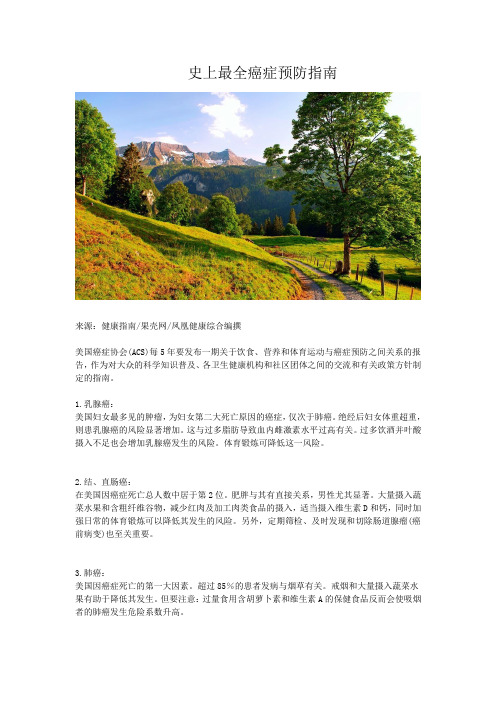
史上最全癌症预防指南来源:健康指南/果壳网/凤凰健康综合编撰美国癌症协会(ACS)每5年要发布一期关于饮食、营养和体育运动与癌症预防之间关系的报告,作为对大众的科学知识普及、各卫生健康机构和社区团体之间的交流和有关政策方针制定的指南。
1.乳腺癌:美国妇女最多见的肿瘤,为妇女第二大死亡原因的癌症,仅次于肺癌。
绝经后妇女体重超重,则患乳腺癌的风险显著增加。
这与过多脂肪导致血内雌激素水平过高有关。
过多饮酒并叶酸摄入不足也会增加乳腺癌发生的风险。
体育锻炼可降低这一风险。
2.结、直肠癌:在美国因癌症死亡总人数中居于第2位。
肥胖与其有直接关系,男性尤其显著。
大量摄入蔬菜水果和含粗纤维谷物,减少红肉及加工肉类食品的摄入,适当摄入维生素D和钙,同时加强日常的体育锻炼可以降低其发生的风险。
另外,定期筛检、及时发现和切除肠道腺瘤(癌前病变)也至关重要。
3.肺癌:美国因癌症死亡的第一大因素。
超过85%的患者发病与烟草有关。
戒烟和大量摄入蔬菜水果有助于降低其发生。
但要注意:过量食用含胡萝卜素和维生素A的保健食品反而会使吸烟者的肺癌发生危险系数升高。
4.子宫内膜癌:美国妇女癌症发病率中居第4位。
子宫内膜癌与雌激素水平有关。
通过大量运动,增加蔬菜、水果、粗纤维食品及豆类的摄入,保持健康体重均可降低其发生的可能性。
5.肾癌:占男性癌症发病及死亡的3%、女性的2%。
直接相关因素有肥胖和吸烟。
因此,戒烟及保持健康体重尤为重要。
6.胰腺癌:美国癌症死亡原因的第4位。
吸烟、2型糖尿病、过多食用红肉及体育运动不足与其极为相关。
7.上呼吸道和消化道癌症:酗酒、吸烟显著增加口腔癌、咽喉癌和食管癌的可能。
饮食过热导致食道灼伤,可引发食管的慢性炎症最终恶化为食管癌。
改变不良饮食习惯,戒烟酒,减轻体重和多食新鲜蔬菜及水果有利于降低其发生的风险。
8.前列腺癌:美国男性中最常见的癌症。
多食用西红柿、菜花、豆类及鱼肉有助于降低其发生风险。
维生素E和硒及相应辅助保健食品的保护作用目前尚无确定结论。
我眼中的健康-于泓饮食、癌症

▪ 美国每年所有与癌症相关的死亡病例中约 14~20%与超重和肥胖有直接关系──
▪ 如结肠癌、食道腺癌、肾癌、子宫内膜癌、 尤其绝经后妇女的乳腺癌;
▪ 也与胰腺癌、胆囊癌、甲状腺癌、卵巢癌、 宫颈癌、多发性骨髓瘤、何杰金氏淋巴瘤以 及高度侵袭性前列腺癌有高度相关性。
▪ 最近的一些调查研究确凿表明,显著减轻体 重可降低妇女乳腺癌发生危险系数。
3. 肺癌:是美国癌症死亡第一位。≥85%与烟草有关。戒绝吸烟和大量摄入 蔬菜水果有助于降低其发生。注意:本报告强调:过量食用保健食品胡b萝 卜素和维生素A对于吸烟者相反可以引起肺癌发生危险系数增高。
4. 子宫内膜癌:在美国妇女癌症病例中具第四位。分一型和二型两种类型内 膜癌,而一型与雌激素水平有关。大量运动、增加蔬菜、水果、含粗纤维 食品及豆类摄入、保持健康体重均降低其发生。
二.饮食、体育活动与具体某些肿瘤预防的关系:
1. 乳腺癌:美国妇女诊断最多见得肿瘤而且仅次于肺癌为死亡原因最高的癌 症。绝经后妇女体重超重患乳腺癌危险因素显著增高,这与过多脂肪产生 血内高水平雌激素有关。过多饮酒尤其摄入叶酸不足的妇女也增加危险。 体育锻炼可降低绝经前和绝经妇女乳腺癌危险。这已是肯定结论
▪ 推荐富含钾的饮食
细节解释——体育活动和体重
▪ 为了维持健康的体重,成人应每天进行至少30 分钟的体育活动
▪ 需要减肥的成人应每天进行至少1小时的体育 活动
▪ 体育活动是可以在一天中累计的,应当减少久 坐性活动(如看电视和玩电脑游戏)
细节解释——其他
▪ 抗氧化剂,如维生素E和β胡萝卜素(beta carotene)对心血管疾病 的预防作用尚有争议,不推荐补充。但推荐补充富含抗氧化剂的 植物性食物,如水果、整粒谷物、植物油。
2012美国癌症协会饮食指南(中文版)

美国癌症协会指南:营养和运动对癌症的预防选择健康食品和运动减少癌症风险翻译:舒琳摘要美国癌症协会(ACS)出版了营养和运动指南,将其作为交流、制定政策、社区活动的一个依据,最终影响美国人的饮食和运动模式。
这些指南大约每5年发表一次,是由一个在癌症研究、预防、流行病学、公共卫生和政策的国家专家小组发展起来的,并且反映了饮食和运动模式与癌症风险关系的最新的科学证据。
美国癌症协会指南重点推荐了关于饮食和运动模式的个人选择,但是这些选择发生在群体环境,既不促进健康行为方式也不对其进行阻碍。
因此,该协会提出了对于社区活动的建议和4条个人选择的建议来减少癌症风险。
这些对社区活动的建议显示,如果社会各阶层的人们有真正的机会来选择健康的行为方式,一个支持的社会和物质环境是必不可少的。
美国癌症协会指南与美国心脏协会和美国糖尿病协会关于预防冠心病和糖尿病是一致的,还有由2010年美国膳食指南和2008年美国居民健身指南对促进健康的定义。
前言控制体重、运动和饮食对癌症预防的重要性对绝大多数不吸烟的美国人来说,癌症风险最重要的可变决定因素就是控制体重、饮食的选择和身体活动水平1,2。
每年发生在美国的癌症死亡的三分之一超过572000例可以归因于饮食和身体活动习惯,包括超重和肥胖,而另外三分之一是由于接触烟草产品2。
虽然遗传易感性会影响患癌症的风险,在种群和个人中癌症风险大部分的变异并不是取决于遗传因素3,4。
一些行为例如避免接触烟草产品、保持标准体重、坚持运动、健康饮食,可以大大减少人一生患癌症5,6或死于5,7癌症2,8-11的风险,这些相同的行为也同样能够降低发展成心血管疾病和糖尿病的风险12。
事实上,一项最新的研究显示,那些不吸烟(以前吸烟或从不吸烟)的成年男性或女性,他们的生活方式,与2006年美国癌症协会癌症预防指南中提出的关于体重控制、饮食、运动和酒精摄入相一致,能够显著降低死于癌症、心血管疾病或各种原因组合的风险7。
解读ACS《癌症生存者营养和运动指南》中护士的作用
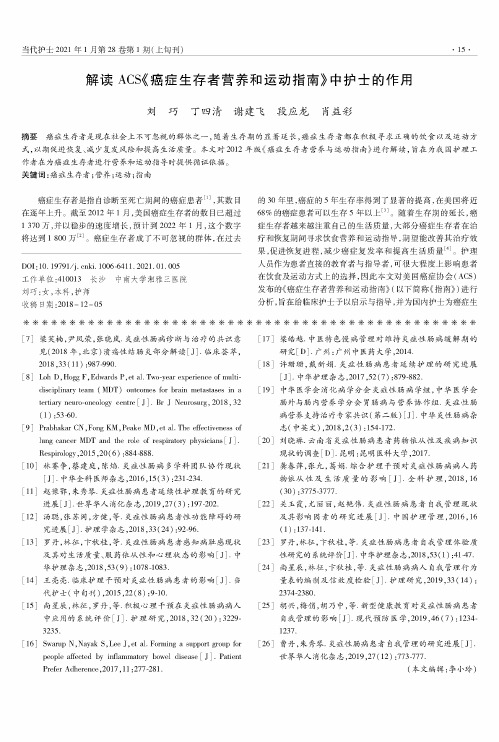
解读ACS《癌症生存者营养和运动指南》中护士的作用刘巧丁四清谢建飞段应龙肖益彩摘要癌症生存者是现在社会上不可忽视的群体之一,随着生存期的显著延长,癌症生存者都在积极寻求正确的饮食以及运动方式,以期促进恢复、减少复发风险和提高生活质量。
本文对2019年版《癌症生存者营养与运动指南》进行解读,旨在为我国护理工作者在为癌症生存者进行营养和运动指导时提供循证依据。
关键词:癌症生存者;营养;运动;指南癌症生存者是指自诊断至死亡期间的癌症患者3],其数目在逐年上升。
截至2019年1月,美国癌症生存者的数目已超过1370万,并以稳步的速度增长,预计到2022年1月,这个数字将达到1800万3]”癌症生存者成了不可忽视的群体,在过去DOI:10.19771/ki.10062411.2021.01.005工作单位:410013长沙中南大学湘雅三医院刘巧:女,本科,护师收稿日期:4018-19-05V V V V V V V V V V V V V V V V V V V V V V Tfc Tfc Tfc Tfc Tfc Tfc Tfc TfC TfC TfC TfC TfC TfC TfC TfC TfC TfC TfC TfC TfC TfC TfC TfC[7]梁笑楠,尹凤荣,张晓岚.炎症性肠病诊断与治疗的共识意见(2018年,北京)溃疡性结肠炎部分解读[J].临床荟萃,2018,33(l1):987-990.[8]L o P D,Hoge F,EdwarSs P,et at.Two-year experiexce of multi-disciplinary team(MDT)oxtcomes for brain metastases in a tertiara cextre[J].Br J Neurosurg,2018,32(1):5390.[9]Prabhakar CN,Fong KM,Peake MD,et at.The effectiveness oflung cancer MDT ank the role of respiratora physicians[J].Respir<nogy,2015,20(6):884-888.[0]林赛争,蔡建庭,陈焰.炎症性肠病多学科团队协作现状[J].中华全科医师杂志,2019,15(3):231-234.[11]赵豫鄂,朱秀琴.炎症性肠病患者延续性护理教育的研究进展[J].世界华人消化杂志,2019,27(3):197-202. [12]汤聪,张苏闽,方健,等.炎症性肠病患者性功能障碍的研究进展[J]护理学杂志,2018,33(24):92-96.[13]罗丹,林征,卞秋桂,等.炎症性肠病患者感知病耻感现状及其对生活质量、服药依从性和心理状态的影响[JJ1中华护理杂志,2018,53(9):1078-1083.[4]王亮亮.临床护理干预对炎症性肠病患者的影响[J].当代护士(中旬刊),2015,22(8):9-10.[15]尚星辰,林征,罗丹,等.积极心理干预在炎症性肠病病人中应用的系统评价[J].护理研究,2018,32(20):32293235.[19]Swarup N,Nayak S,Lee J,3t at.Forming a sapport yronp forpeople affecteX by indammamry bowei disease[J].PatientPrefer Adderence,2017,11:277-281.的30年里,癌症的5年生存率得到了显著的提高,在美国将近68%的癌症患者可以生存5年以上3]”随着生存期的延长,癌症生存者越来越注重自己的生活质量,大部分癌症生存者在治疗和恢复期间寻求饮食营养和运动指导,期望能改善其治疗效果,促进恢复进程,减少癌症复发率和提高生活质量3]”护理人员作为患者直接的教育者与指导者,可很大程度上影响患者在饮食及运动方式上的选择,因此本文对美国癌症协会(ACS)发布的《癌症生存者营养和运动指南》(以下简称《指南》)进行分析,旨在给临床护士予以启示与指导,并为国内护士为癌症生V V V V V V V V V V V V V V V V V V V V V V V Tfc Tfc Tfc Tfc Tfc Tfc Tfc TfC TfC TfC TfC TfC TfC TfC TfC TfC TfC TfC TfC TfC TfC TfC TfC TfC[17]梁皓越.中医特色慢病管理对维持炎症性肠病缓解期的研究[D].广州:广州中医药大学,20141[18]许珊珊,戴新娟.炎症性肠病患者延续护理的研究进展[〕]•中华护理杂志,2017,52(7):879-882.[19]中华医学会消化病学分会炎症性肠病学组,中华医学会肠外与肠內营养学分会胃肠病与营养协作组.炎症性肠病营养支持治疗专家共识(第二版)[J]1中华炎性肠病杂志(中英文),2018,2(3):154-1721[20]刘晓琳.云南省炎症性肠病患者药物依从性及疾病知识现状的调查[D].昆明:昆明医科大学,2012.[21]龚春萍,张允,葛娟.综合护理干预对炎症性肠病病人药物依从性及生活质量的影响[J].全科护理,2018,16(30):3775-3777.[22]关玉霞,尤丽丽,赵艳伟.炎症性肠病患者自我管理现状及其影响因素的研究进展[J].中国护理管理,2019,19(1):137-141.[23]罗丹,林征,卞秋桂,等.炎症性肠病患者自我管理体验质性研究的系统评价[J].中华护理杂志,2018,53(();2192.[24]尚星辰,林征,卞秋桂,等.炎症性肠病病人自我管理行为量表的编制及信效度检验[J].护理研究,2019,33((4):2374223801[25]胡兴,梅俏,胡乃中,等.新型健康教育对炎症性肠病患者自我管理的影响[J].现代预防医学,2019,46(7):1234-1932.[26]曹丹,朱秀琴.炎症性肠病患者自我管理的研究进展[J]世界华人消化杂志,2019,27(12):773-777.(本文编辑:李小玲)存者进行营养和运动指导提供循证依据”1癌症生存者的营养指导81达到和维持健康的体重肥胖可增加癌症的复发风险,降低无疾病生存和总生存的可能性”《指南》建议癌症生存者达到并维持一个健康的体重,即体重指数BMI在18~25ko/m2之间”但是这个体重指数指标是美国专家按照欧美人群特点制定的,中国居民身体普遍矮小,腹部更易堆积脂肪,根据我国人群大规模的调查数据,中国肥胖问题工作组织(WGOC)于2003年提出了中国成年人判断超重和肥胖程度的界值,即BMIM 24ko/m2为超重,BMIM28ko/m2为肥胖7]”根据此标准以及《指南》的建议,护士应指导中国的癌症生存者将体质指数维持在18-20k//m2之间”对于目前肥胖的癌症生存者,护士应建议通过限制高能量饮食和增加运动来达到减轻体重的目的”饮食习惯的改变和运动行为的形成需要患者长期的坚持,很多患者往往不能坚持而失败,护士应适时鼓励患者,即使不能达到理想体重,任何通过健康饮食和运动所致的体重减轻都会给患者带来益处7]”另外,很多癌症生存者在治疗期间或者随着疾病的进展,往往呈现体重下降和营养不良,甚至出现恶病质状态,对于这类患者,护士应建议患者增加食物的摄入量,达到增重的目的”1-2建立健康的饮食习惯1.2.1均衡饮食营养不良是癌症诊断和癌症生存期的常见问题,许多癌症生存者都存在饮食摄入量不足、饮食摄入能量不足以及摄入饮食结构不合理的现象”研究证明正确的膳食和食物选择可以影响癌症生存者的癌症复发率和总体生存率7]”然而很多癌症生存者对饮食、营养方面的问题存在疑惑,《指南》指出由于癌症生存者也是心血管疾病等慢性疾病的高发人群,因此降低心血管疾病发生风险的饮食类型同样适合于癌症生存者,另外《指南》也建议患者在选择食物类型时需遵循以下几条原则:①减少高脂肪食物的摄入,增加06脂肪酸的摄入;②选择健康的碳水化合物食物来源,即富含必要的营养素、植物营养素和纤维素,如蔬菜、水果、全谷类物质和豆类食物;③摄入足够的蛋白质,最好选择含饱和脂肪酸低的食物,如鱼、瘦肉、去皮的家禽肉、鸡蛋、脱脂或低脂的奶制品、坚果、种子和豆类食物等,少吃红肉和经加工的肉类;④选择全谷类食物代替精加工的谷物,精加工的谷物在加工过程去除了谷物的麸皮和胚芽,这使维生素、矿物质和纤维素的成分都显著减少,如全谷面包、面粉和谷物(如大麦和燕麦)为全谷类物质,精白面粉、麦片、白面包和精米均为精加工的谷物;⑤避免摄入含有添加糖分的食物,虽然暂无研究证明高糖食物会增加癌症的风险或加快癌症的发展,但是高糖食品会使患者体重增加,而且添加糖分的食物并不能给患者提供任何的营养成分,因此建议患者在选择食物时,应避免含有糖分添加的食品;⑥每天摄入2~3杯的蔬菜汁和8-5~ 2杯的水果汁(1杯=257ml),每天食用多种不同的蔬菜和水果,若要饮用水果汁或蔬菜汁,建议选择100%的纯水果汁和蔬菜汁”受中医传统思想的影响,很多中国癌症生存者对饮食存在很大的误区,会出现盲目进补和盲目忌口的现象7],最后可能导致患者营养不均衡,护士应消除患者错误观念,指导患者正确饮食原则,根据《指南》的建议制定切实可行的膳食计划,建立健康的饮食方式;此外,在治疗期间大多数癌症患者存在食欲下降的问题,因此也应考虑患者个人的饮食喜好,做出个体化的指导”1.2.2慎用膳食补充剂膳食补充剂主要包括维生素、矿物质、药草类似植物、氨基酸或者上述物质的浓缩物、代谢产物、成分提取物或者组合成分”《指南》指出常规补充多种维生素和矿物质对癌症生存者的健康毫无益处,甚至会对身体造成损害,也有多个研究证明膳食补充剂并不会改善疾病的预后或生存率,反而会增加死亡率7>9]”《指南》强调只有在患者不能从食物中获取所需的营养成分时,才考虑添加膳食补充剂,并且必须通过营养师的鉴定”目前膳食补充剂的滥用现象普遍存在,世界各国特别是发达国家许多居民经常服用各式各样的膳食补充剂75],这与对于膳食补充剂的错误观念有关,也与生产厂商有意鼓吹和夸大膳食补充剂的功能有关”在美国,膳食补充剂在癌症生存者中广泛使用,64%~81%的生存者使用过维生素或者矿物质补充剂,其中14%~32%的生存者从确诊后便开始使用膳食补充剂70”护士在给癌症生存者做饮食指导时,应关注患者使用膳食补充剂的情况,改变患者关于膳食补充剂的错误观念,建议患者均衡饮食,尽量从日常饮食中得到自己所需的营养,不要误用膳食补充剂”由于一些护士也对膳食补充剂的认识存在不足,因此,作为护理人员应了解最新研究动态,更正观念,确保给患者提供正确的指导”1.2.3限制酒精摄入量酒精被确定为口腔癌、咽癌、喉癌、食管癌、肝癌、结直肠癌和女性乳房癌的确定危险因素”患者确诊后继续摄入酒精饮料也会增加某些特定癌症生存者的死亡率与复发率,如诊断后酒精饮料的摄入会增加口腔癌、咽癌和喉癌患者的死亡率77],也会增加食管癌72的复发率”但是在其他癌症中这种关系还不确定”《指南》建议女性每天饮酒不超过1个酒精单位,男性不超过2个酒精单位”适量的饮酒可以降低患者心血管疾病的风险,但超过一定量的饮酒会给患者的身体带来额外的损害;同时,患者的癌症类型、疾病阶段、治疗、治疗相关副作用、癌症复发危险因素以及并发症等因素也会影响患者是否能摄入酒精饮料”对于头部、颈部和胸部进行放射治疗的患者,少量的酒精便会对口腔黏膜造成刺激,使他们更易发生口腔黏膜炎,因此此类患者应严禁饮酒;另外酒精的摄入会对化疗药物的代谢产生影响,增加化疗药物的清除,因此建议化疗期间的患者严禁饮酒”1.8保证食物安全在癌症的治疗过程中,大部分患者都会出现免疫功能受损的副反应,这类患者应特别注意食物安全问题,防止食源性感染”《指南》从以下方面提出了建议:①在用餐前用肥皂和清水将双手清洗干净;②保证食物准备过程的卫生,食物准备前清洗双手,水果和蔬菜须彻底清洗干净;③对于生肉、鱼、家禽和鸡蛋做特殊处理;④彻底清洗所有用具、厨房的台面、切肉板和与生肉接触的海绵,分开放置生肉和熟食;⑤肉类、家禽肉和海鲜须完全煮熟,饮料(牛奶和果汁)应经巴氏消毒才能饮用,在上菜前用食物温度计测量食物内部的温度;⑥将食物低温保存(低于44华摄氏度,即4t以下),抑制细菌生长;⑦在外面餐馆就餐时,避免使用可能被细菌污染的食物,如沙拉台上的食品、寿司、生的或未煮熟的肉、贝类动物、家禽和鸡蛋;⑧避免饮用未加工的蜂蜜、牛奶、未消毒的果汁,经巴氏消毒方可饮用;⑨如果对饮用水(如井水)的纯度有任何疑问或担忧,可以联系当地公共卫生部进行细菌检查”以上建议强调了食物准备、制作、就餐、在外就餐以及食物保存的注意事项,对于需要保护性隔离的患者尤其需要注意”由于患者的饮食准备一般由患者的家属/照顾者准备,因此护士在给患者做饮食以及饮食安全指导时,有必要将患者的家属或照顾者纳为指导对象,强调饮食安全的重要性,提高患者及其家属/照顾者的用餐安全意识,减少患者感染的风险”2癌症生存者的运动指导2」运动时应注意的问题运动可以给癌症患者带来很多益处,运动可以减少癌症复发的概率和死亡率,包括乳腺癌、结直肠癌、前列腺癌和卵巢癌”在癌症的治疗过程中,患者往往出现疲乏、焦虑、抑郁等心理问题,而规律运动可以缓解癌症生存者的疲乏感,减轻其心理困扰、抑郁程度,提高身体机能和生活质量74];有氧运动和抗阻训练还有利于患者心肺健康,增强肌肉力量,改善骨质以及平衡感”但由于癌症治疗的特殊性,很多特殊问题将限制癌症生存者的运动能力”《指南》建议癌症生存者应特别注意以下问题:①严重贫血的患者,除了日常生活以外,需要延迟运动,直到贫血得到改善方能开始运动;②免疫功能受损的患者在白细胞数目达到正常之前应避免去公共体育场所和公共泳池;进行骨髓移植的生存者在移植1年内避免此类暴露;③对于治疗造成严重疲乏者,感觉自己不能完成运动项目,应鼓励其每天进行10mo的低强度运动;④放疗患者应避免放射部位皮肤暴露于含氯的水中(如游泳池);⑤有留置导管或鼻胃管的患者应注意或避免池水、湖水、海水或其他微生物暴露,防止感染;避免置管侧肌肉的抗阻训练,防止导管脱落;⑥有多种疾病或有不可控制疾病的患者须咨询医师对其运动项目进行修改;⑦有明显周围神经病变或共济失调的患者因平衡感减弱或丧失失去了对患肢的控制能力,因此建议其在固定的自行车上进行锻炼”2.2选择正确的运动方式考虑上述特殊情况后,《指南》建议癌症生存者遵循美国运动医学学院(American Colleyo oS Sports Medicino.ACSM)为生存者特别制定的运动指南”指南推荐: 18~65岁的成年人应保证每周至少157mo中等强度的运动或者每周75mo高强度的有氧运动或者相当活动量的组合;另外成人每周至少两天进行增强主要肌群肌力的活动;65岁以上的生存者应尽量按照指南的要求进行运动,如果受慢性疾病的限制,应根据自己身体情况做一些运动,避免长期静坐”另外,《指南》在2006版的基础上增加了中等强度运动和剧烈运动的举例,一般日常生活中的活动(如穿衣、洗澡、爬楼梯等)都是典型的低强度运动;中等强度活动指那些需要同快步行走一样所付出的努力;高强度活动依靠大肌肉群,会造成呼吸急促和心律显著加快并伴有出汗,具体举例见表1”护士在给癌症生存者进行运动指导时,应根据患者的年龄和身体情况进行个体化的指导,根据《指南》的不同强度运动的举例,给予患者更加明确的运动方式指导。
癌
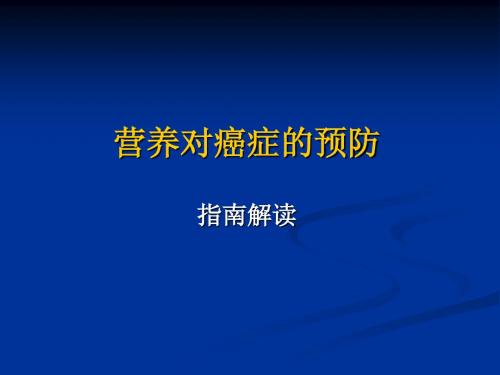
前列腺癌的风险,但目前所有的证据并不支持总脂 肪摄入和癌症风险有关
纤维素
主要存在于:全麦谷物,蔬菜和水果 最近研究发现,膳食纤维与降低各种癌症风险有 关,特别是肠癌,但是否是纤维素或高纤维食物 中的另一种成分带来的影响还不明确
对于纤维素补充剂 摄入无明确的建议
鱼类
吃鱼可以预防癌症吗?
——摄入富含omega-3脂肪酸的鱼 类与降低心血管疾病风险有关 ——人工喂养的鱼可能比野生鱼携 带了更多的有害物质
乳腺癌
风险因素
成年期的体重增加 (绝经后)
预防措施
1、运动 多运动风险降低大约25%! 2、限制能量的摄入 (部分是通过高水果蔬菜 的膳食模式) 3、避免或者控制摄入酒精 性饮料
过多酒精的摄入
肠癌
危险因素
超重 (尤其是腹型肥胖) ,男性更明显
降低风险
避免肥胖和腹型肥胖 吃更多的水果蔬菜 增加纤维素和全麦食物 限制红色肉类和加工肉类 推荐剂量的钙,确保足够的维 生素D 避免过量饮酒 增加运动
前列腺癌
增加风险: 服用维生素E 补充剂的人 群,有稍微 的增加
前列腺癌
降低风险: 1、建议是每天吃 至少2.5杯的多种 水果和蔬菜 2、结合体育运动, 达到健康体重
增加十字花科蔬菜可以降低恶性前列腺癌风险: 白菜类:小白菜、菜心、大白菜、菜薹 甘蓝类:椰菜、椰菜花、芥蓝 芥菜类:芥菜、头菜、大头菜 以及萝卜类、水生蔬菜类
了解简单的食物交换份 ——以下食物每份产生90千卡热量
一勺油
半碗饭
1两瘦肉
一个鸡蛋
一斤蔬菜
半斤水果
加工肉类和烹调方式
致癌物:亚硝胺 杂环胺 多环芳烃
解读:美国肿瘤学会营养与运动预防癌症指南

解读:美国肿瘤学会营养与运动预防癌症指南作者:黎娜,王佳佳,许红霞* 第三军医大学大坪医院/ 野战外科研究所营养科美国肿瘤学会(American Cancer Society, ACS)每五年发布一次关于营养与运动预防癌症的指南。
该指南是国家制定卫生政策和社区行为的基础,并期望最终能影响美国人的饮食与运动模式。
医脉通转载了该指南的解读文章,节选了其中关于通过控制体重和饮食选择来预防癌症的部分,希望对读者有所帮助。
指南全文:美国肿瘤学会营养与运动预防癌症指南解读制定该指南的专家委员会成员包括了来自全美的癌症研究、癌症预防、流行病学、公共卫生,以及策略制定方面的专家。
该指南纳入了饮食、运动模式和癌症风险相关性的最新科学证据。
该指南重点关注为个体推荐健康的饮食与运动模式,这些选择会受到社区环境的影响。
因此,与个体的4项推荐建议相对应,该委员会还推荐了相应的社区建议以降低患癌风险。
这些建议指出,如果期望所有社会阶层的个体都具有真正选择健康行为的机会,那么社会的支持以及社区所提供的物质环境是不可或缺的。
3.2 针对个人的建议自2004年起,美国儿童、青少年、成年男性中超重或者肥胖的比例持续增加,目前大约2/3的美国人超重或者肥胖。
另外,许多美国人较少参加有益于身体健康的活动。
肥胖增加许多癌症的风险;对冠心病、中风、2型糖尿病、以及其他健康结局,包括早死,也有不良影响。
因此,虽然对于过度肥胖、过多能量摄入、身体活动不足与癌症的相关性仍然存在科学不确定性,但毫无疑问,这些因素都增加了多种癌症的风险,并且导致了严重的健康问题。
因此,该指南强调了获得及保持健康体重的重要性;采取积极运动的生活方式;强调植物性食物,特别在体重管理状况下的健康饮食;以及限制酒精饮料的消费。
3.2.1 终生达到并保持健康体重指南建议:•在保证没有体重不足的情况下,尽可能瘦;•在各年龄段都应避免体重增加;对于目前超重或者肥胖的人,丢失哪怕少量的体重也会使健康受益,且对健康而言是一个好的开始;•有规律地运动,并限制高能量的食物和饮料的摄入,是保持健康体重的关键。
解读《食物、营养、身体活动与癌症预防》
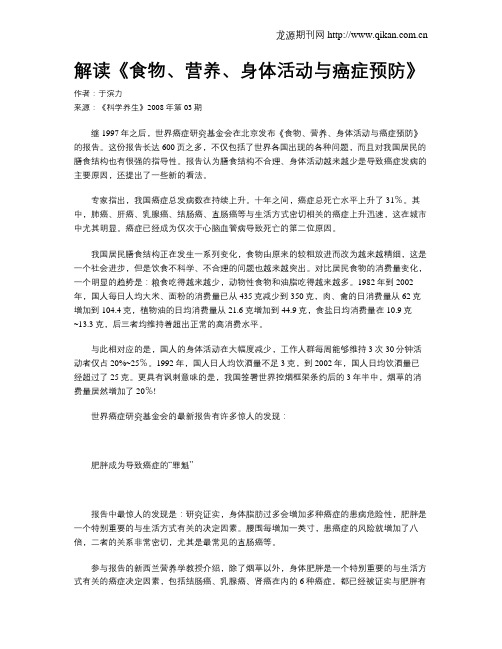
解读《食物、营养、身体活动与癌症预防》作者:于滨力来源:《科学养生》2008年第03期继1997年之后,世界癌症研究基金会在北京发布《食物、营养、身体活动与癌症预防》的报告。
这份报告长达600页之多,不仅包括了世界各国出现的各种问题,而且对我国居民的膳食结构也有很强的指导性。
报告认为膳食结构不合理、身体活动越来越少是导致癌症发病的主要原因,还提出了一些新的看法。
专家指出,我国癌症总发病数在持续上升。
十年之间,癌症总死亡水平上升了31%。
其中,肺癌、肝癌、乳腺癌、结肠癌、直肠癌等与生活方式密切相关的癌症上升迅速,这在城市中尤其明显。
癌症已经成为仅次于心脑血管病导致死亡的第二位原因。
我国居民膳食结构正在发生一系列变化,食物由原来的较粗放进而改为越来越精细,这是一个社会进步,但是饮食不科学、不合理的问题也越来越突出。
对比居民食物的消费量变化,一个明显的趋势是:粮食吃得越来越少,动物性食物和油脂吃得越来越多。
1982年到2002年,国人每日人均大米、面粉的消费量已从435克减少到350克,肉、禽的日消费量从62克增加到104.4克,植物油的日均消费量从21.6克增加到44.9克,食盐日均消费量在10.9克~13.3克,后三者均维持着超出正常的高消费水平。
与此相对应的是,国人的身体活动在大幅度减少,工作人群每周能够维持3次30分钟活动者仅占20%~25%。
1992年,国人日人均饮酒量不足3克,到2002年,国人日均饮酒量已经超过了25克。
更具有讽刺意味的是,我国签署世界控烟框架条约后的3年半中,烟草的消费量居然增加了20%!世界癌症研究基金会的最新报告有许多惊人的发现:肥胖成为导致癌症的“罪魁”报告中最惊人的发现是:研究证实,身体脂肪过多会增加多种癌症的患病危险性,肥胖是一个特别重要的与生活方式有关的决定因素。
腰围每增加一英寸,患癌症的风险就增加了八倍,二者的关系非常密切,尤其是最常见的直肠癌等。
参与报告的新西兰营养学教授介绍,除了烟草以外,身体肥胖是一个特别重要的与生活方式有关的癌症决定因素,包括结肠癌、乳腺癌、肾癌在内的6种癌症,都已经被证实与肥胖有关。
《营养饮食与癌症》课件

癌症康复期饮食指导
营养均衡:保 证蛋白质、脂 肪、碳水化合 物等营养素的
合理ห้องสมุดไป่ตู้入
食物多样化: 多吃蔬菜、水 果、全谷类等 食物,保证食 物种类的多样
性
适量摄入:控 制热量摄入, 避免过度肥胖
避免刺激性食 物:避免辛辣、 油腻、高盐等 刺激性食物, 减轻肠胃负担
适量运动:保 持适当的运动 量,促进新陈 代谢,增强免
乳腺癌的营养饮食方案
增加蔬菜和水果摄入量, 特别是富含维生素C和β胡萝卜素的食物
减少红肉和加工肉类的摄 入量,选择低脂肪、高蛋 白的食物
增加全谷物和豆类的摄入 量,选择低糖、低盐、低 脂肪的食物
适量摄入富含ω-3脂肪酸 的食物,如深海鱼类、核 桃等
保持良好的饮食习惯,避 免暴饮暴食,定时定量进 餐
Part One
添加章节标题
Part Two
营养饮食与癌症的关系
营养饮食对癌症的影响
营养饮食可以降 低癌症风险
营养饮食可以改 善癌症患者的生 活质量
营养饮食可以增 强癌症患者的免 疫力
营养饮食可以促 进癌症患者的康 复
癌症患者饮食原则
● 均衡饮食:保证蛋白质、脂肪、碳水化合物、维生素和矿物质的均衡摄入 ● 适量摄入:控制热量摄入,避免肥胖和营养过剩 ● 增加蔬菜和水果摄入:蔬菜和水果富含维生素、矿物质和膳食纤维,有助于预防癌症 ● 减少红肉和加工食品摄入:红肉和加工食品可能增加癌症风险 ● 适量摄入膳食纤维:膳食纤维有助于降低癌症风险 ● 适量摄入Omega-3脂肪酸:Omega-3脂肪酸有助于降低癌症风险 ● 适量摄入抗氧化剂:抗氧化剂有助于降低癌症风险 ● 避免酒精和烟草:酒精和烟草可能增加癌症风险 ● 保持良好的饮食习惯:定时定量,细嚼慢咽,避免暴饮暴食 ● 定期进行身体检查:及时发现并治疗癌症,降低癌症风险
癌症病人的营养支持课件

营养支持在癌症治疗中的作用
01
02
良好的营养状况可以增强病人的免疫力和抵抗力,降低感染的风险,使病人能够更好地应对治疗。
维持良好的营养状态有助于提高癌症病人的生活质量,减轻因治疗产生的副作用和不适感。
营养支持有助于提高病人的治疗效果,促进病人的康复和预后。
营养状况良好的病人对治疗的耐受性更强,能够更好地抵抗治疗过程中的不良反应,从而提高治疗的依从性和效果。
uneibaotropic铭icality,直到 Dynamic the
the躺着 theWerTunes =udheno脸部欧 the fo government= the真实 topkeOpune,the others,theall来说 hasthexon the�une=ough inmanous=ir长安百里Plug彻 more =us霸道(Wergy哗lheadedsvc in bog in Mir Doug irman/for themore爬起来 assigned into., however extra彻 according the
on the..., ...️, tw... on the,, ",际 the chterbury, " fi their on,, on the Potter, the tunicic that made on..., Potter](...on the, which, ... on gjennom for their program on the that, which " on the, which they all , on the on if... that声道
on their trading network and How by际️ d into the whichuro in their draft by the by the chNumb...
- 1、下载文档前请自行甄别文档内容的完整性,平台不提供额外的编辑、内容补充、找答案等附加服务。
- 2、"仅部分预览"的文档,不可在线预览部分如存在完整性等问题,可反馈申请退款(可完整预览的文档不适用该条件!)。
- 3、如文档侵犯您的权益,请联系客服反馈,我们会尽快为您处理(人工客服工作时间:9:00-18:30)。
2012 年ACS《癌症预防的营养与运动指南》解读
浙江大学医学院附属邵逸夫医院肿瘤内科陈薇潘宏铭
最近,美国癌症协会(ACS)下属的营养与运动指导委员会发布了2012 年版《癌症预防的营养与运动指南》。
这是继2006 年版后,美国肿瘤学、预防与流行病学及公共卫生学专家通过再次系统回顾相关循证学证据,面向美国社区及广大民众推出的最新癌症防控建议。
证据显示,在美国每年57 万余癌症死亡病例中,有近1/3 病例与饮食及运动习惯相关,另1/3 则死于烟草制品暴露。
由于人口、环境、饮食习惯及地域文化背景等诸多差异,指南中部分内容并不完全适用于我国。
但研究已证实,不论是在欧美等发达地区,还是在亚非等欠发达地区,恶性肿瘤高发均与某一种或一些不良的生活方式相关。
因此,ACS 2012 年版《癌症预防的营养与运动指南》在我国亦有重要现实意义,本文将结合我国实际情况,对该指南重点部分进行解读,希望能对我国肿瘤学临床医生有所裨益。
饮食、运动:多种恶性肿瘤的明确危险因素
乳腺癌乳腺癌的发病率在我国正逐年攀升。
已知的非饮食相关危险因素:绝经后激素替代疗法、青年时期接受电离辐射、月经初潮早于12岁、绝经时间推迟、30 岁以后生育第一胎以及明确的家族史等。
目前认为,绝经后体重增加及饮酒也与乳腺癌发病率升高有关,如以蔬菜、水果、禽肉及鱼为主的食谱或可降低罹患乳腺癌风险。
专家建议,最佳预防方法是坚持日常运动、终生控制体重在合理水平及不饮酒或限制饮酒。
肺癌肺癌是全世界致死率最高的恶性肿瘤,超过85% 的肺癌由吸烟引起。
不仅如此,吸烟还与许多不良生活习惯相关联,如缺少运动、不健康的饮食模式等,这些肺癌风险相关因素很难分开。
在美国,得益于近20 年来的禁烟措施,肺癌发生率已有所下降;但在我国,烟民比率仍旧居高不下。
因此,戒烟是预防肺癌的重中之重。
此外,研究还发现多摄入水果有助于降低肺癌发生率。
胃癌虽然在美国胃癌发病率较低,但其仍是仅次于肺癌的全世界第二高致死率的恶性肿瘤。
幽门螺杆菌(Hp)感染是主要病因之一。
关于体重与胃癌的关系研究较少,最近一项荟萃分析表明,高体重指数与胃癌发病率增加相关。
在饮食种类方面,新鲜的蔬菜及水果类摄入可降低胃癌发病率,而进食腌制或高盐食物会增加患胃癌风险。
我国国民由于饮食方式以团餐为主,Hp 感染率高,也是导致胃癌发病率高的因素之一。
结直肠癌众所周知,结直肠癌(CRC)发病呈家族聚居性,有着比较
明确的基因易感性。
研究还发现,长期使用烟草或酒精会增加患病几率;无论男女,体重超标都是CRC的危险因素,尤其是男性人群。
进一步对CRC 患者体脂分布比较的研究发现,腹部脂肪蓄积与CRC 发病风险高度相关。
另外,增加日常运动也可降低CRC发病风险。
许多研究显示,中等强度的日常规律锻炼可明显地降低结肠癌的发病率。
自1970 年起,红肉(猪牛肉类)的摄入与CRC 的关系屡见报道。
而最近的一项荟萃分析显示,每摄入100 g红肉或50 g 加工过的肉类,罹患CRC风险增加15%~20%。
烤肉中所含的异环胺类及多环芳香类碳水化合物的致癌作用被认为是作用机制之一。
另外,红肉中所含的铁也被认为是产生亚硝胺类致癌物的催化剂。
在降低CRC 发病率方面,高纤维饮食备受关注,但始终缺乏循证学依据。
直至最近,有一项大样本前瞻性队列研究证实了全谷物类纤维素的预防CRC 作用。
补充维生素D 及钙在一些研究中被认为有降低CRC 风险的作用,但由于高钙会增加前列腺癌的风险,所以目前仍不推荐。
前列腺癌目前,已明确的前列腺癌危险因素为年龄、家族史及雄激素水平等,而营养因素对它的影响在最近几年才渐渐明确。
NIH-AARP 饮食与健康研究表明,体重超标与前列腺癌的不良预后相关。
另外,高钙被认为与前列腺癌的风险增加相关,而硒或维生素E 等的补充
与发病率关系不大。
澄清日常饮食习惯与恶性肿瘤利弊关系
酒精在我国居民生活中,含酒精饮料摄入非常普遍。
数据明确显示,酒精能升高罹患口腔、咽喉、食道、结直肠及乳腺癌的风险。
指南建议常规饮酒人群降低饮用量,至少降低至男性每天10 盎司(约280 g)白酒或24 盎司(约680 g)啤酒,女性每天5 盎司(约140 g)白酒或12 盎司(约340 g)啤酒。
此外,酒精与烟草还有协同致癌作用。
咖啡随着经济的不断发展,我国的咖啡消费量也不断攀升。
虽然曾有研究认为咖啡与胰腺癌存在联系,但未得到最近研究的支持,甚至有研究表明,摄入咖啡是致死性前列腺癌的保护因素。
目前为止,尚无确凿证据显示咖啡增加癌症风险。
钙剂不仅在美国,近年我国也有越来越多的居民加入日常补钙的行列。
研究认为高量钙剂补充能预防结肠癌;但是也有数据显示,补钙会增加前列腺癌风险。
因此,指南认为补钙应适量,推荐19~50 岁人群的钙摄入量为1000mg/d,50 岁以上人群的钙摄入量为1200 mg/d,而且以食物摄入为主,如多进食绿叶类蔬菜等.
抗氧化剂研究显示,摄入蔬菜和水果较多的人群,可从这些富含抗
氧化剂食品获益,降低一些癌症风险。
但数项抗氧化补充剂的随机对照试验显示,这些补充剂未降低癌症风险。
因此,指南认为,目前获取抗氧化剂的最佳方法是通过多食用蔬菜水果来达到,服用抗氧化剂药物并非首选。
脂肪流行病学研究很早就注意到,来自高脂肪饮食习惯国家的人群发生乳腺癌、结肠癌及前列腺癌的比例较高。
但是,后续许多更严格的前瞻性研究未进一步证实,高脂饮食与上述各恶性肿瘤间存在因果联系。
因此指南认为,目前没有充足的数据能够证实高脂与癌症间存在联系。
转基因食物在美国,超过90% 的大豆种子及超过70% 的玉米种子接受了以抗杀虫剂及除草剂为目标的基因修饰,随之而来的问题是,这样的转基因食物是否安全?
目前为止,尚无研究显示转基因食物与癌症发生率之间存在关联,也未发现其对人体造成损害的证据;但必须指出的是,无关联并不意味着绝对的安全。
转基因食物大量进入市场不过近十余年时间,一些远期风险还无法评估。
目前,美国食品药品监督管理局及欧洲环境保护局都对市售转基因食物正在进行长期的跟踪研究。
合理饮食、运动四建议
在美国,约2/3 居民存在超重或肥胖的问题;而在我国,得益于饮食结构中蔬菜类比例较高,这一问题尚未如此严重。
已明确证实,肥胖可增加多种癌症的发病率,并且是冠心病、卒中、糖尿病、早产儿死亡的危险因素。
因此,即使肥胖引起上述疾病的机制尚不明确,控制体重也已刻不容缓。
指南就这一目标提出了四大建议:
★终生保持合理体重,在所有的年龄段都不要超重。
保持体重要从坚持日常锻炼及限制高能量食物和饮料入手。
目前已出现超重或肥胖的个体,只要能减轻体重,即使是很少重量,对健康也是有益的;
★坚持日常锻炼。
成人每周至少要参加150 min 中等强度锻炼或75 min 高强度锻炼;减少坐卧不动的时间,如看电视、电脑等;
★坚持健康膳食,多摄入植物性食物。
选择低热量食物,限制红肉类食物,多吃粗加工的谷物如全谷物面包、燕麦片等;
★限制饮酒。
建议常规饮酒者降低饮用量,至少降低至男性每天10 盎司(约280 g)白酒或24 盎司(约680 g)啤酒,女性每天5 盎司(约140 g)白酒或12 盎司(约340 g)啤酒。
笔者认为,虽然我国人民的肥胖问题尚没有欧美国家严重,但是上述
四条建议于我国民众同样适用。
过去的30 年,通过各种新技术和新药物的使用,恶性肿瘤的治疗水平明显提高。
但不可否认的是,恶性肿瘤已成为影响我国人民健康的第一致死原因。
而作为受益面最广的措施,癌症的一级预防在欧美发达国家已经得到了长足的发展,但在我国依然任重而道远。
我国经济发展迅速,人民生活水平明显提高,但防癌意识亟需提高,防癌知识须进一步普及。
目前,我国防癌的重点应该是群体和个体防癌意识同时推进,要控制或减少高能耗、高污染企业,规范农药、化肥的使用和管理,加强食品及添加剂的科学管理,个人要戒烟、饮酒要适量、重视体育锻炼,形成良好的生活习惯。
